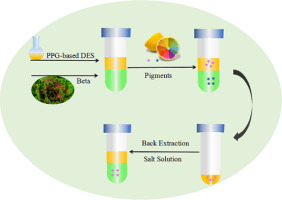Talanta ( IF 6.1 ) Pub Date : 2018-01-08 , DOI: 10.1016/j.talanta.2018.01.014 Hongmei Zhang , Yuzhi Wang , Yigang Zhou , Jing Chen , Xiaoxiao Wei , Panli Xu

|
Deep eutectic solvent (DES) composed of polypropylene glycol 400 (PPG 400) and tetrabutylammonium bromide (TBAB) was combined with a series of new-type salts such as quaternary ammonium salts, amino acid and polyols to form Aqueous Biphasic Systems (ABSs). Phase-forming ability of the salts was investigated firstly. The results showed that polyols had a relatively weak power to produce phases within studied scopes. And the shorter of carbon chain length of salts, the easier to obtain phase-splitting. Then partitioning of three pigments in PPG 400/betaine-based ABSs was addressed to investigate the effect of pigments’ hydrophobicity on extraction efficiency. It was found that an increase in hydrophobicity contributed to the migration of pigments in the DES-rich phase. On the other hand, with a decline in phase-forming ability of salts, the extraction efficiency of the whole systems started to go down gradually. Based on the results, selective separation experiment was conducted successfully in the PPG 400/betaine-based systems, including more than 93.00% Sudan Ⅲ in the top phase and about 80.00% sunset yellow FCF/amaranth in the bottom phase. Additionally, ABSs constructed by DES/betaine for partitioning amaranth were further utilized to explore the performances of influence factors and back extraction. It can be concluded that after the optimization above 98.00% amaranth was transferred into the top phase. And 67.98% amaranth can be transferred into the bottom phase in back-extraction experiment. At last, dynamic light scattering (DLS) and transmission electron microscope (TEM) were applied to probe into extraction mechanism. The results demonstrated that hydrophobicity played an important role in the separation process of pigments. Through combining with new-type DES, this work was devoted to introducing plentiful salts as novel compositions of ABSs and providing an eco-friendly extraction way for partitioning pigments, which boosted development of ABSs in the monitoring food safety field.
中文翻译:

由深共熔溶剂和新型盐形成的水两相体系,用于颜料的高效萃取
将由聚丙二醇400(PPG 400)和四丁基溴化铵(TBAB)组成的深共熔溶剂(DES)与一系列新型盐(例如季铵盐,氨基酸和多元醇)混合,形成双相水溶液体系(ABSs)。首先研究了盐的相形成能力。结果表明,在所研究的范围内,多元醇具有相对弱的产生相的能力。并且盐的碳链长度越短,越容易获得相分离。然后解决了在PPG 400 /基于甜菜碱的ABS中分配三种颜料的问题,以研究颜料的疏水性对萃取效率的影响。发现疏水性的增加有助于颜料在富含DES的相中的迁移。另一方面,由于盐的相形成能力下降,整个系统的提取效率开始逐渐下降。基于这些结果,在PPG 400 /甜菜碱基体系中成功进行了选择性分离实验,其中上阶段的苏丹红Ⅲ含量超过93.00%,下阶段的日落黄FCF / ama呋喃含量超过80.00%。此外,进一步利用由DES /甜菜碱构建的用于划分s菜的ABS来探索影响因素和反萃取的性能。可以得出结论,经过优化,高于98.00%的mar菜已转移到了顶相中。在反萃取实验中,6菜籽中有67.98%的a菜可以转移到底部。最后,利用动态光散射(DLS)和透射电子显微镜(TEM)对提取机理进行了探讨。结果表明,疏水性在颜料的分离过程中起着重要作用。通过与新型DES结合,这项工作致力于引入丰富的盐作为ABS的新型成分,并提供了一种生态友好的提取方法来分配颜料,这促进了ABS在食品安全监控领域的发展。


























 京公网安备 11010802027423号
京公网安备 11010802027423号